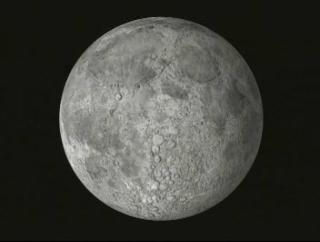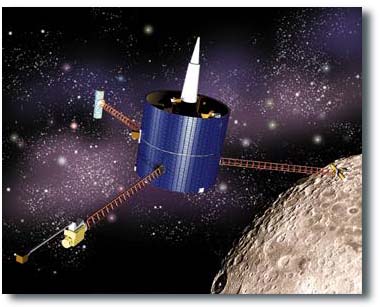|
|
Lunar Prospector was
launched into space on
What
would you do, now in the future……?
It was to be a routine exploration of the
South Pole-Aitken Basin and then to Moon Base Prime, "Luna 1" in the
year 2081; however, it turned into a struggle for survival as well as a scientific
opportunity. It's still unknown what really happened and why the spacecraft
began to have problems just over the Basin, but the fact remains that the
specialized spacecraft, "Armstrong 1", did crash into the lunar soil
~110.2 km away from Luna 1. After the crash, the spaceship was totally disabled
and outside help was no longer an option despite video satellite uplinks.
This story
is of a group of highly intelligent, young, and adventures professionals on
their daring yet scientific quest to get to Moon Base Prime, "Luna 1"
while facing the hardships and wonderment of space.
Armstrong 1 Transmission Log (optional)
Last Transmission from Mission Control ß “click file here” : File
2.4. REMOTE Access
Have
headphones or speaker ready
Click on
hyperlink file above
You may
click on the OPEN or SAVE option at this point.
If you click on
SAVE, continue with directions:
Save on
desktop main screen or designated folder
Minimize
this browser by clicking on the minimize button [ _ ] in the far upper right
corner
Click twice
on icon on desktop or file VDOLuna at saved folder location
Close video
window when concluded
Click on
minimized window in task bar at bottom of the screen to return
You may
delete the file from the computer at anytime
Moon Anchors
The Task
You and your group are to return to Earth after your ordeal. Once on Earth you have been invited to make a video presentation about crash landing on the moon and the actual trip to Moon Base Luna 1 through the South Pole-Aitken Basin. Because the crew is composed of specialists in the field of Earth-Space Science, each "fellow scientist" is responsible for researching information related to their field and sharing in your experience within the video and by creating a portfolio containing all research, scripts, outlines, materials, etc..

South Pole of the Moon Containing the
Location of the Futuristic “Armstrong 1” Crash Site and “Luna
Base 1” Colony Years
After the Crash of the Lunar Prospector
![]()
Divide into
team members of three or four "scientists." Each group member must
choose one of the following (not all characters may be used for the project):
Health
Officer: is responsible
for all medical, biological, and chemical affects with the human body in space.
Lunar
Geologist: is
responsible for any information about the geological nature and landscape of
the moon.
Space
Mechanic: is responsible
for electronic and/or engineering devices that are used by NASA for lunar
explorations.
Navigation
Officer: is responsible for
piloting, directing and maintaining headings and lunar map charting and
plotting.
Communications
Officer: is responsible
for message translations and any correspondence during the explorations.
Moon
Historian: is
responsible for any historical events pertaining to the moon and/or space
travel.
Astrophysicist: is responsible for space science,
theories, and events
Other: if the group deems it necessary to have
another member title on the team.
(must clear
"Other" with teacher first).
Each group
will go on a "downloading" expedition prior to the trip to the moon
via the ship's data computer.
Gather at
least 3 computer references about how your particular field would relate to
this assignment.
All
references/information must be obtained by the computer (internet). Exceptions are notes and/or your text which
may be used to “supplement” your video.
Each member
of the team must use or implement at least 5 facts from their research in the
video.
Referencing
the material on a separate sheet of paper is optional; however, it may help
your grade. All members must participate.
From the
information gathered, develop the Moon Crash story by following the listed
guidelines:
Portfolio: All information, references, sketches, research, outline/script and/or
any other items that pertained to your video must be turned in as a portfolio
(folder)
An outline or general script is
required to go along with the video and is to be turned in as part of the
portfolio. Either the outline or script
does not have to be “word for word”.
Video: Project should be well managed and rehearsed, educational yet creative,
and properly videoed in the areas of grammar, technology, professionalism, and
censorship:
No member of the team is to be
seen during the video. ONLY “voice-overs” are to be used. Characters, backdrops, props, illustrations,
animation, drawings, and manipulatives are to be made or used.
A total of 10-20 minutes for the
video is required. Remember that quality
is more important than quantity.
The story must last at least 3-5
Earth days.
At least 5 facts (not theories)
are needed in the video about how “each” field and/or character would relate to
the mission.
You may use “stand-in’s” (other
people) with your video.
Must be in DVD format (otherwise
make other arrangements).
Each member of the team needs to
have about equal time on the video.
Having a separate person (not on the team) to run and/or direct the
video is high suggested. No member of the team is to die.
Introduction to extra ordinary
items and/or creatures must be done in a theoretical manner.
Safety is to be highly stressed
(ie. no fire, no explosions, and/or no real guns of any kind (exception is
water)).
Have credits before and/or after
the video.
Other: If necessary, type or write any items that should be overlooked or
ignored within the portfolio and/or video.
These items will then not be held against you and/or your group. You may also include any concerns or problems
that need to be addressed prior to grading.
Computer Data
Resources
No unauthorized sites are to be explored unless you have
permission from mission control. Links from authorized sites may be explored
freely. Writing, typing, and/or printing are allowed; however, do so with
minimal paper usage and inconvenience to other crew members. Again, since
communication is completely gone, no form of emailing, chatting, and/or instant
messaging is possible or allowed.
You Are Allowed to Use Your E-Text Book and/or Lecture
Notes Along with the Following
Select
a Site by "Clicking" on the Term or Title in the Boxes Above
Explore
Other Sources for Information that Pertain to Your Character or Story
Despite the Fact that many of the Links Above are
Specific to Your Character, It’s Wise View All the Links to
Because They Too May Have Useful Information and/or Links!
![]()
|
Collaboration Rubric of Moon Crash Here (click on "A") Each Member of the Crew Needs to Review Grading Rubrics |
![]()
Your
scientific exploration and experience have just taken you on a trip across the
moon. As you noticed, sharing what you have learned is an essential part of
scientific inquiry, but so are the arguments and debates you and your crew
members must have had. Perhaps you noticed areas of disagreement over materials
to take, what to do with the materials, and/or over scientific knowledge from
each of your disciplines. In the science of astronomy these are very important
issues. What would you have taken differently or have done differently to
prepare you for another..... MOON CRASH ?
In
the Event of a Concern or Question about the Project, You and/or the Crew May
Send an…
Click the Distressed Ship Above to Commence
Transmission
For a Copy of a Project Help Guide
“Click on Armstrong 1” Below

